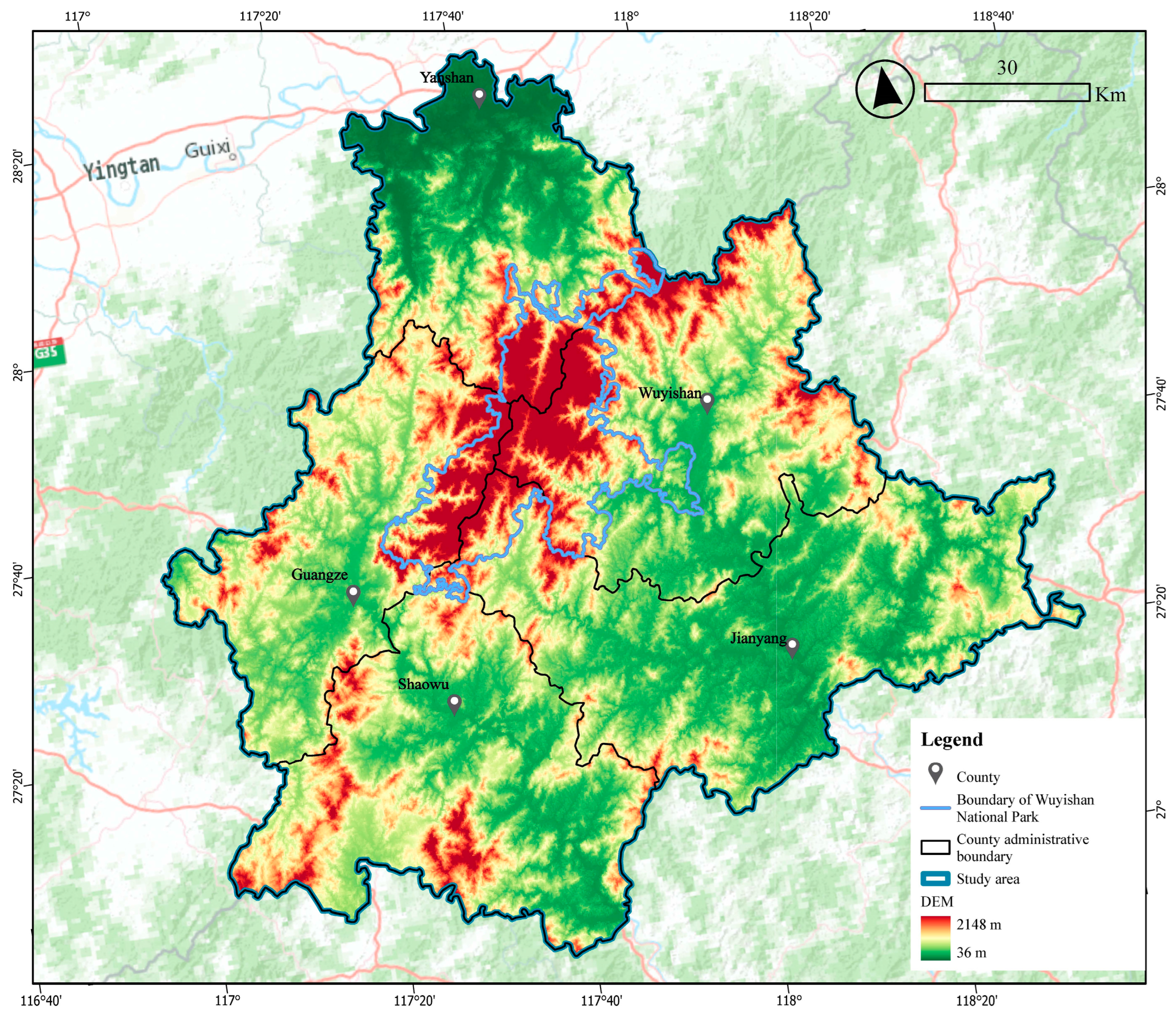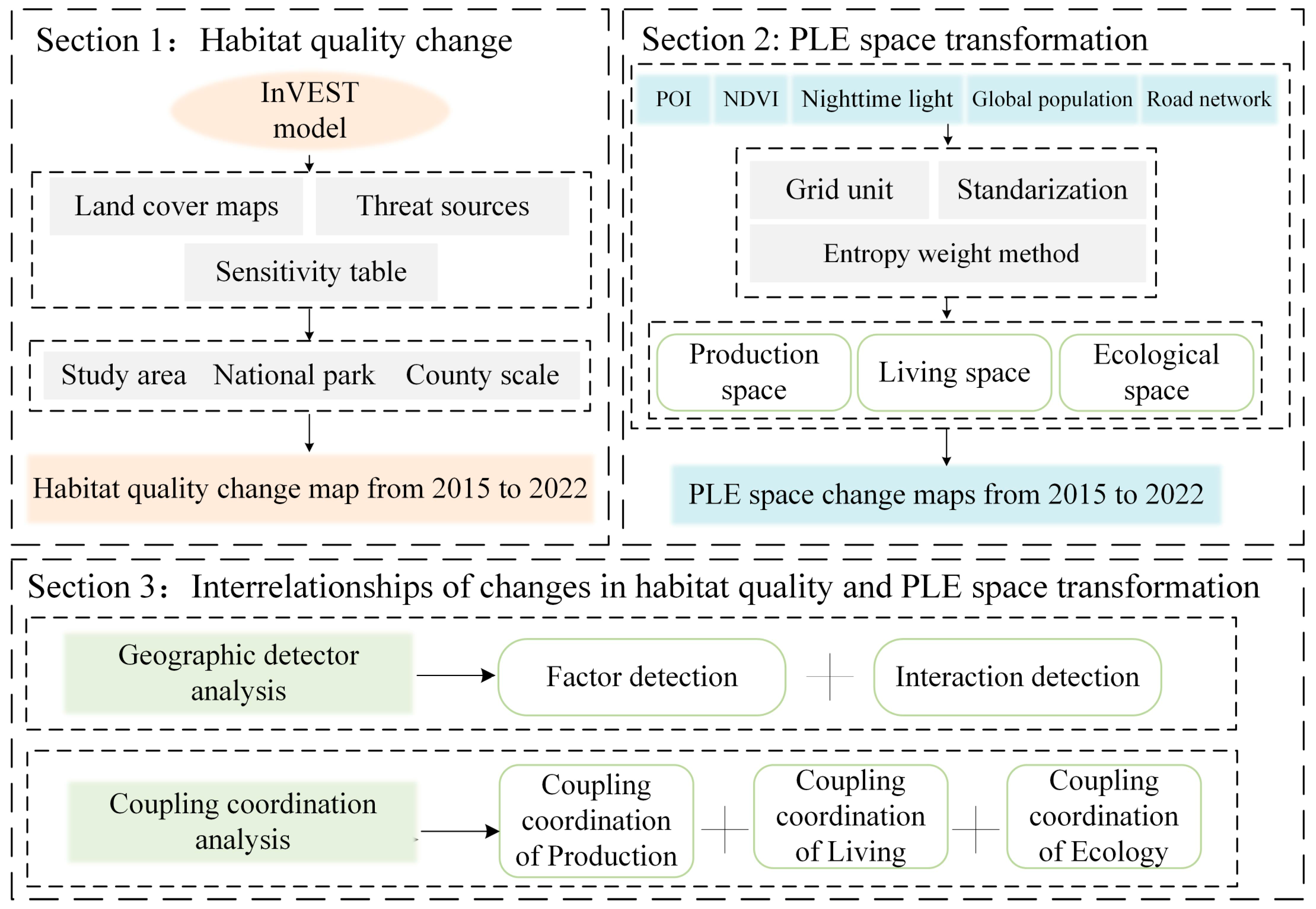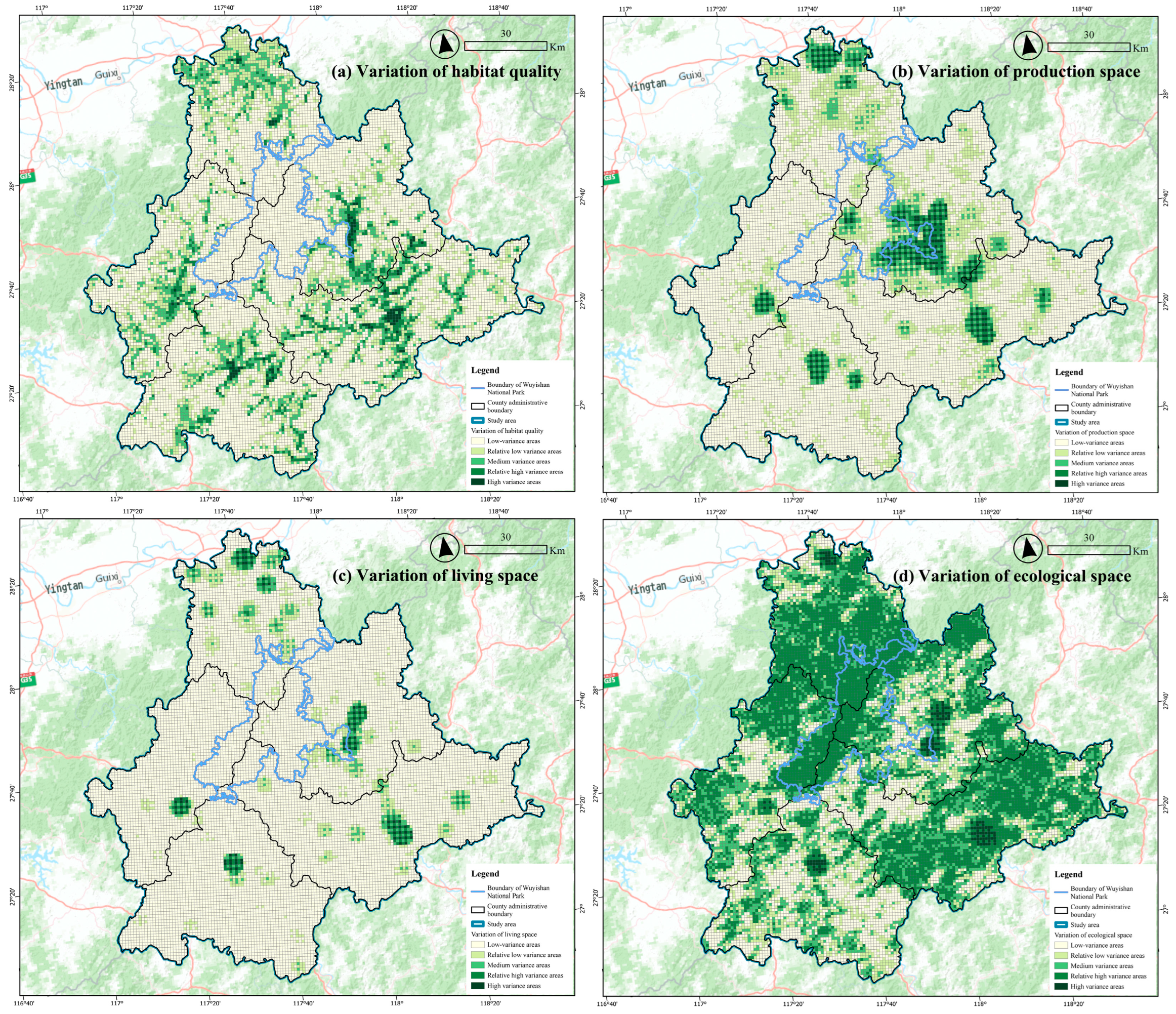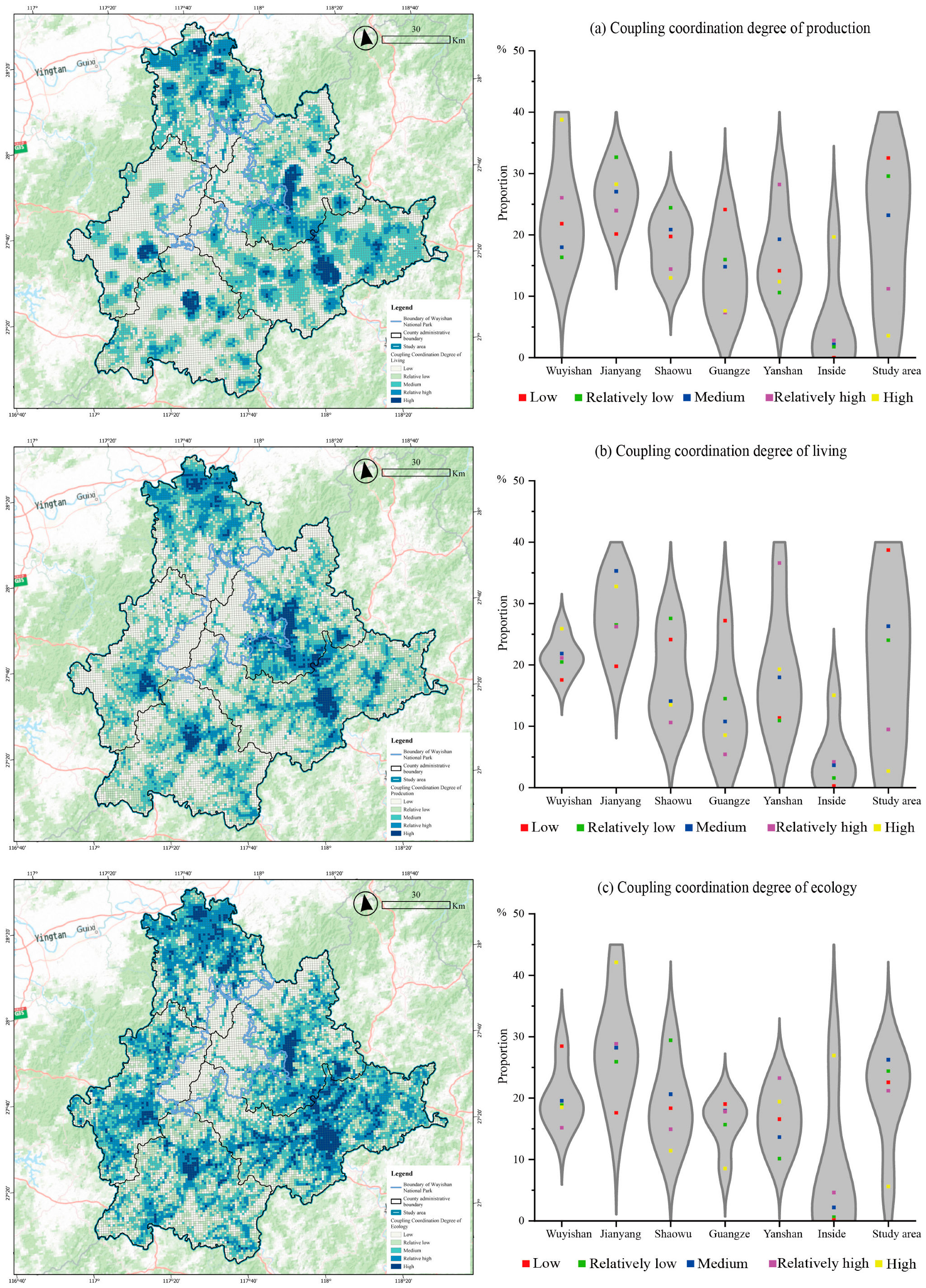Assessing the Trade-off between Ecological Conservation and Local Development in Wuyishan National Park: A Production–Living–Ecological Space Perspective
Abstract
:1. Introduction
2. Materials and Methods
2.1. Study Area
2.2. Methods
2.2.1. Habitat Quality Model
2.2.2. Calculating Indicator Weights to Identify PLE Space
2.2.3. Landscape Pattern Calculation
2.2.4. Geographical Detector Model
2.2.5. Coupling Coordination Degree Model
2.3. Data Source and Pre-Processing
3. Results
3.1. Variation Analysis of Habitat Quality
3.2. Variation Analysis of Production-Living-Ecological Space
3.2.1. Spatial Analysis of PLE Space Variation
3.2.2. Multiple Scale Analysis of PLE Space Variation
3.2.3. Connectivity Analysis of PLE Space Variation
3.3. Geographic Detector Analysis of Habitat Quality Change and PLE Space Transformations
3.4. Coupling Coordination Analysis of Habitat Quality Change and PLE Space Transformations
3.4.1. Coupling Coordination Degree of Production
3.4.2. Coupling Coordination Degree of Living
3.4.3. Coupling Coordination Degree of Ecology
4. Discussion
4.1. Habitat Quality Change
4.2. PLE Space Transformations
4.3. Interrelationships of Changes in Habitat Quality and PLE Space Transformations
5. Conclusions
Author Contributions
Funding
Data Availability Statement
Acknowledgments
Conflicts of Interest
Appendix A
| Threat Factor | Maximum Influence Distance/km | Weight | Decay Type |
|---|---|---|---|
| Rainfed cropland | 1 | 0.5 | Linear decay |
| Irrigated cropland | 3 | 0.7 | Linear decay |
| Impervious surfaces land | 8 | 1 | Exponential decay |
| Shrubland | 3 | 0.3 | Exponential decay |
| Grassland | 1 | 0.2 | Exponential decay |
| Land Use Type | Habitat Suitability | Rainfed Cropland | Irrigated Cropland | Impervious Surfaces | Shrubland | Grassland |
|---|---|---|---|---|---|---|
| Rainfed cropland | 0.5 | 0 | 0.9 | 0 | 0.3 | 0.3 |
| Irrigated cropland | 0.3 | 0.9 | 0 | 0 | 0.4 | 0.4 |
| Evergreen broadleaved forest | 1 | 0.6 | 0.8 | 0.9 | 0.5 | 0.6 |
| Deciduous broadleaved forest | 1 | 0.6 | 0.8 | 0.9 | 0.5 | 0.6 |
| Needle-leaved forest | 1 | 0.6 | 0.8 | 0.9 | 0.5 | 0.6 |
| Shrubland | 0.7 | 0.3 | 0.4 | 0.7 | 0 | 0.5 |
| Grassland | 0.7 | 0.3 | 0.4 | 0.7 | 0.5 | 0 |
| Wetland | 1 | 0.4 | 0.5 | 0.7 | 0.5 | 0.5 |
| Impervious surfaces | 0 | 0 | 0 | 0 | 0 | 0 |
| Water body | 1 | 0.5 | 0.5 | 0.8 | 0.6 | 0.7 |
References
- Newbold, T.; Hudson, L.N.; Hill, S.L.L.; Contu, S.; Lysenko, I.; Senior, R.A.; Börger, L.; Bennett, D.J.; Choimes, A.; Collen, B.; et al. Global Effects of Land Use on Local Terrestrial Biodiversity. Nature 2015, 520, 45–50. [Google Scholar] [CrossRef] [PubMed]
- Jaung, W.; Carrasco, L.R. A Big-Data Analysis of Human-Nature Relations in Newspaper Coverage. Geoforum 2022, 128, 11–20. [Google Scholar] [CrossRef]
- Sandbrook, C.; Fisher, J.A.; Holmes, G.; Luque-Lora, R.; Keane, A. The Global Conservation Movement Is Diverse but Not Divided. Nat. Sustain. 2019, 2, 316–323. [Google Scholar] [CrossRef]
- Weng, A.; Liao, L.; Cao, Y.; Carver, S.; Lin, L.; Shen, S.; Xu, Z.; Dong, J.; Lan, S.; Yang, R. Different People, Different Wild: Comparing and Mapping Wilderness Representation in Wuyishan National Park, China. Geogr. Sustain. 2024, 5, 144–156. [Google Scholar] [CrossRef]
- Wassihun, A.N.; Feleke, F.B.; Bayeh, G.A.; Nega, Y.M. Smallholder Households’ Willingness to Pay for Conservation of Ecosystem Services of Altash National Park of Ethiopia. Int. J. Geoheritage Parks 2021, 9, 405–414. [Google Scholar] [CrossRef]
- Bell, J.; Stockdale, A. Evolving National Park Models: The Emergence of an Economic Imperative and Its Effect on the Contested Nature of the ‘National’ Park Concept in Northern Ireland. Land Use Policy 2015, 49, 213–226. [Google Scholar] [CrossRef]
- Phongchiewboon, A.; Farrelly, T.; Hytten, K.; Holland, J. Political ecology, privation and sustainable livelihoods in northern Thailand’s national parks. J. Political Ecol. 2020, 27, 360–377. [Google Scholar] [CrossRef]
- Musakwa, W.; Gumbo, T.; Paradza, G.; Mpofu, E.; Nyathi, N.A.; Selamolela, N.B. Partnerships and Stakeholder Participation in the Management of National Parks: Experiences of the Gonarezhou National Park in Zimbabwe. Land 2020, 9, 399. [Google Scholar] [CrossRef]
- Musakwa, W.; Mpofu, E.; Nyathi, N.A. Local Community Perceptions on Landscape Change, Ecosystem Services, Climate Change, and Livelihoods in Gonarezhou National Park, Zimbabwe. Sustainability 2020, 12, 4610. [Google Scholar] [CrossRef]
- Schelhas, J.; Sherman, R.E.; Fahey, T.J.; Lassoie, J.P. Linking Community and National Park Development: A Case from the Dominican Republic. Nat. Resour. Forum 2002, 26, 140–149. [Google Scholar] [CrossRef]
- Hiwasaki, L. Toward Sustainable Management of National Parks in Japan: Securing Local Community and Stakeholder Participation. Environ. Manag. 2005, 35, 753–764. [Google Scholar] [CrossRef] [PubMed]
- Mayer, M.; Müller, M.; Woltering, M.; Arnegger, J.; Job, H. The Economic Impact of Tourism in Six German National Parks. Landsc. Urban. Plan. 2010, 97, 73–82. [Google Scholar] [CrossRef]
- Mika, M.; Zawilińska, B.; Pawlusiński, R. Exploring the Economic Impact of National Parks on the Local Economy: Functional Approach in the Context of Poland’s Transition Economy. Hum. Geogr. 2016, 10, 5–21. [Google Scholar]
- Zhang, X.; Liao, L.; Huang, Y.; Fang, Q.; Lan, S.; Chi, M. Conservation Outcome Assessment of Wuyishan Protected Areas Based on InVEST and Propensity Score Matching. Glob. Ecol. Conserv. 2023, 45, e02516. [Google Scholar] [CrossRef]
- Feng, Y.; Li, G.; Li, J.; Sun, X.; Wu, D. Community Stewardship of China’s National Parks. Science 2021, 374, 268–269. [Google Scholar] [CrossRef] [PubMed]
- Guo, Y.; Liu, X.; Liu, X.; Zhang, J.; Zhang, H.; Fan, J.; Khan, N.; Ma, J. Quantitative Assessment of the Degree of Harmony between Humanity and Nature for National Parks in China: A Case Study of the Three-River-Source National Park. Front. Ecol. Evol. 2023, 11, 1121189. [Google Scholar] [CrossRef]
- Dong, Q.; Zhang, B.; Cai, X.; Morrison, A.M. Do Local Residents Support the Development of a National Park? A Study from Nanling National Park Based on Social Impact Assessment (SIA). Land 2021, 10, 1019. [Google Scholar] [CrossRef]
- Sheng, G.; Chen, H.; Ferretti-Gallon, K.; Innes, J.L.; Wang, Z.; Zhang, Y.; Wang, G. Moving toward a Greener China: Is China’s National Park Pilot Program a Solution? Land 2020, 9, 489. [Google Scholar] [CrossRef]
- Wang, B.; He, S.; Min, Q.; Yang, X. Conflict or Coexistence? Synergies between Nature Conservation and Traditional Tea Industry Development in Wuyishan National Park, China. Front. Sustain. Food Syst. 2023, 6, 991847. [Google Scholar] [CrossRef]
- Chen, S.; Sun, X.; Su, S. A Study of the Mechanism of Community Participation in Resilient Governance of National Parks: With Wuyishan National Park as a Case. Sustainability 2021, 13, 10090. [Google Scholar] [CrossRef]
- He, S.; Gallagher, L.; Min, Q. Examining Linkages among Livelihood Strategies, Ecosystem Services, and Social Well-Being to Improve National Park Management. Land 2021, 10, 823. [Google Scholar] [CrossRef]
- Wei, Y.; He, S.; Li, G.; Chen, X.; Shi, L.; Lei, G.; Su, Y. Identifying Nature–Community Nexuses for Sustainably Managing Social and Ecological Systems: A Case Study of the Qianjiangyuan National Park Pilot Area. Sustainability 2019, 11, 6182. [Google Scholar] [CrossRef]
- Schelhas, J.; Pfeffer, M.J. When Global Environmentalism Meets Local Livelihoods: Policy and Management Lessons. Conserv. Lett. 2009, 2, 278–285. [Google Scholar] [CrossRef]
- Job, H.; Bittlingmaier, S.; Mayer, M.; von Ruschkowski, E.; Woltering, M. Park–People Relationships: The Socioeconomic Monitoring of National Parks in Bavaria, Germany. Sustainability 2021, 13, 8984. [Google Scholar] [CrossRef]
- Zhang, X.; Liao, L.; Xu, Z.; Zhang, J.; Chi, M.; Lan, S.; Gan, Q. Interactive Effects on Habitat Quality Using InVEST and GeoDetector Models in Wenzhou, China. Land 2022, 11, 630. [Google Scholar] [CrossRef]
- Puhakka, R.; Saarinen, J. New Role of Tourism in National Park Planning in Finland. J. Environ. Dev. 2013, 22, 411–434. [Google Scholar] [CrossRef]
- Wang, K.; Wang, M.; Gan, C.; Chen, Q.; Voda, M. Tourism Economic Network Structural Characteristics of National Parks in the Central Region of China. Sustainability 2021, 13, 4805. [Google Scholar] [CrossRef]
- Yang, Y.; Bao, W.; Liu, Y. Coupling Coordination Analysis of Rural Production-Living-Ecological Space in the Beijing-Tianjin-Hebei Region. Ecol. Indic. 2020, 117, 106512. [Google Scholar] [CrossRef]
- Zhang, X.; Xu, Z. Functional Coupling Degree and Human Activity Intensity of Production–Living–Ecological Space in Underdeveloped Regions in China: Case Study of Guizhou Province. Land 2021, 10, 56. [Google Scholar] [CrossRef]
- Chen, X.; Yu, L.; Cao, Y.; Xu, Y.; Zhao, Z.; Zhuang, Y.; Liu, X.; Du, Z.; Liu, T.; Yang, B.; et al. Habitat Quality Dynamics in China’s First Group of National Parks in Recent Four Decades: Evidence from Land Use and Land Cover Changes. J. Environ. Manag. 2023, 325, 116505. [Google Scholar] [CrossRef]
- Li, J.; Sun, W.; Li, M. Linlin Meng Coupling Coordination Degree of Production, Living and Ecological Spaces and Its Influencing Factors in the Yellow River Basin. J. Clean. Prod. 2021, 298, 126803. [Google Scholar] [CrossRef]
- Liang, T.; Yang, F.; Huang, D.; Luo, Y.; Wu, Y.; Wen, C. Land-Use Transformation and Landscape Ecological Risk Assessment in the Three Gorges Reservoir Region Based on the “Production–Living–Ecological Space” Perspective. Land 2022, 11, 1234. [Google Scholar] [CrossRef]
- Duan, Y.; Wang, H.; Huang, A.; Xu, Y.; Lu, L.; Ji, Z. Identification and Spatial-Temporal Evolution of Rural “Production-Living-Ecological” Space from the Perspective of Villagers’ Behavior—A Case Study of Ertai Town, Zhangjiakou City. Land Use Policy 2021, 106, 105457. [Google Scholar] [CrossRef]
- Fu, C.; Tu, X.; Huang, A. Identification and Characterization of Production–Living–Ecological Space in a Central Urban Area Based on POI Data: A Case Study for Wuhan, China. Sustainability 2021, 13, 7691. [Google Scholar] [CrossRef]
- Lin, G.; Jiang, D.; Fu, J.; Zhao, Y. A Review on the Overall Optimization of Production–Living–Ecological Space: Theoretical Basis and Conceptual Framework. Land 2022, 11, 345. [Google Scholar] [CrossRef]
- Li, H.; Fang, C.; Xia, Y.; Liu, Z.; Wang, W. Multi-Scenario Simulation of Production-Living-Ecological Space in the Poyang Lake Area Based on Remote Sensing and RF-Markov-FLUS Model. Remote Sens. 2022, 14, 2830. [Google Scholar] [CrossRef]
- Liu, C.; Wang, Y.; He, R.; Wang, C. An Analysis Framework for Identifying and Optimizing Ecological-Production-Living Space Based on Resident Behavior. J. Nat. Resour. 2019, 34, 2113. [Google Scholar] [CrossRef]
- Shi, T.; Yang, S.; Zhang, W.; Zhou, Q. Coupling Coordination Degree Measurement and Spatiotemporal Heterogeneity between Economic Development and Ecological Environment—Empirical Evidence from Tropical and Subtropical Regions of China. J. Clean. Prod. 2020, 244, 118739. [Google Scholar] [CrossRef]
- Yang, D.; Yang, Q.; Tong, Z.; Du, W.; Zhang, J. Coupling Coordination Analysis of Production, Living, and Ecological Spaces in Wetlands: A Case Study of Xianghai Wetland Nature Reserve, China. Ecol. Indic. 2024, 158, 111578. [Google Scholar] [CrossRef]
- Liao, G.; He, P.; Gao, X.; Deng, L.; Zhang, H.; Feng, N.; Zhou, W.; Deng, O. The Production–Living–Ecological Land Classification System and Its Characteristics in the Hilly Area of Sichuan Province, Southwest China Based on Identification of the Main Functions. Sustainability 2019, 11, 1600. [Google Scholar] [CrossRef]
- Tian, F.; Li, M.; Han, X.; Liu, H.; Mo, B. A Production–Living–Ecological Space Model for Land-Use Optimisation: A Case Study of the Core Tumen River Region in China. Ecol. Model. 2020, 437, 109310. [Google Scholar] [CrossRef]
- Chang, Y.; Zou, T.; Yoshino, K.; Luo, S.; Zhou, S. Ecological Policy Benefit Valuation Based on Public Feedback: Forest Ecosystem Services in Wuyishan Nature Reserve, China. Sci. Total Environ. 2019, 673, 622–630. [Google Scholar] [CrossRef] [PubMed]
- Liu, G.; Yang, Z.; Chen, B.; Zhang, L.; Zhang, Y.; Su, M. An Ecological Network Perspective in Improving Reserve Design and Connectivity: A Case Study of Wuyishan Nature Reserve in China. Ecol. Model. 2015, 306, 185–194. [Google Scholar] [CrossRef]
- Lin, S.; Hu, X.; Chen, H.; Wu, C.; Hong, W. Spatio-Temporal Variation of Ecosystem Service Values Adjusted by Vegetation Cover: A Case Study of Wuyishan National Park Pilot, China. J. For. Res. 2022, 33, 851–863. [Google Scholar] [CrossRef]
- Qi, T.; Li, Y.; Huang, M.; Luo, B.; Peng, Z.; Wang, W.; Li, S.; Degen, A.A.; Shang, Z. Land Intensification Use Scenarios Based on Urban Land Suitability Assessment of the National Park. Sustain. Cities Soc. 2024, 102, 105229. [Google Scholar] [CrossRef]
- Tang, Z. An Integrated Approach to Evaluating the Coupling Coordination between Tourism and the Environment. Tour. Manag. 2015, 46, 11–19. [Google Scholar] [CrossRef]
- Zhou, H.; Wu, X.; Nie, H.; Wang, X.; Zang, S. Coupling Coordination Analysis and Obstacle Factors Identification of Rural Living-Production-Ecological Functions in a Farming-Pastoral Ecotone. Ecol. Indic. 2024, 158, 111398. [Google Scholar] [CrossRef]
- McGarigal, K.S.; Cushman, S.; Neel, M.; Ene, E. FRAGSTATS V4: Spatial Pattern Analysis Program for Categorical Maps. Fragstats. 2021. Available online: https://fragstats.org/ (accessed on 2 April 2024).
- Haines-Young, R.; Chopping, M. Quantifying Landscape Structure: A Review of Landscape Indices and Their Application to Forested Landscapes. Prog. Phys. Geogr. Earth Environ. 1996, 20, 418–445. [Google Scholar] [CrossRef]
- Wang, J.-F.; Zhang, T.-L.; Fu, B.-J. A Measure of Spatial Stratified Heterogeneity. Ecol. Indic. 2016, 67, 250–256. [Google Scholar] [CrossRef]
- Wang, J.; Haining, R.; Zhang, T.; Xu, C.; Hu, M.; Yin, Q.; Li, L.; Zhou, C.; Li, G.; Chen, H. Statistical Modeling of Spatially Stratified Heterogeneous Data. Ann. Am. Assoc. Geogr. 2024, 114, 499–519. [Google Scholar] [CrossRef]
- Hu, Y.; Xu, E.; Dong, N.; Tian, G.; Kim, G.; Song, P.; Ge, S.; Liu, S. Driving Mechanism of Habitat Quality at Different Grid-Scales in a Metropolitan City. Forests 2022, 13, 248. [Google Scholar] [CrossRef]
- Song, Y.; Wang, J.; Ge, Y.; Xu, C. An Optimal Parameters-Based Geographical Detector Model Enhances Geographic Characteristics of Explanatory Variables for Spatial Heterogeneity Analysis: Cases with Different Types of Spatial Data. GIScience Remote Sens. 2020, 57, 593–610. [Google Scholar] [CrossRef]
- Zhou, D.; Xu, J.; Lin, Z. Conflict or Coordination? Assessing Land Use Multi-Functionalization Using Production-Living-Ecology Analysis. Sci. Total Environ. 2017, 577, 136–147. [Google Scholar] [CrossRef]
- Dobson, J.; Bright, E.; Coleman, P.; Durfee, R.; Worley, B. LandScan: A Global Population Database for Estimating Populations at Risk. Photogramm. Eng. Remote Sens. 2000, 66, 849–857. [Google Scholar]
- Wu, Y.; Shi, K.; Chen, Z.; Liu, S.; Chang, Z. An Improved Time-Series DMSP-OLS-like Data (1992–2023) in China by Integrating DMSP-OLS and SNPP-VIIRS. 2021. Available online: https://dataverse.harvard.edu/dataset.xhtml?persistentId=doi:10.7910/DVN/GIYGJU (accessed on 2 April 2024).
- Gao, J.; Shi, Y.; Zhang, H.; Chen, X.; Zhang, G.; Shen, W.; Xiao, T.; Zhang, Y. China Regional 250 m Fractional Vegetation Cover Data Set (2000–2022); National Tibetan Plateau Data Center: Beijing, China, 2023. [Google Scholar]
- Zhang, X.; Liu, L.; Zhao, T.; Chen, X.; Lin, S.; Wang, J.; Mi, J.; Liu, W. GWL_FCS30: A Global 30 m Wetland Map with a Fine Classification System Using Multi-Sourced and Time-Series Remote Sensing Imagery in 2020. Earth Syst. Sci. Data 2023, 15, 265–293. [Google Scholar] [CrossRef]
- Deng, Y.; Yang, R. Influence Mechanism of Production-Living-Ecological Space Changes in the Urbanization Process of Guangdong Province, China. Land 2021, 10, 1357. [Google Scholar] [CrossRef]
- He, S.; Yang, L.; Min, Q. Community Participation in Nature Conservation: The Chinese Experience and Its Implication to National Park Management. Sustainability 2020, 12, 4760. [Google Scholar] [CrossRef]
- Song, T. The Exploration of China’s National Park System Pilot Project: Taking Northeast China Tiger and Leopard National Park System Pilot Area as an Example. Int. J. Geoheritage Parks 2020, 8, 203–209. [Google Scholar] [CrossRef]
- Zhou, D.Q.; Edward Grumbine, R. National Parks in China: Experiments with Protecting Nature and Human Livelihoods in Yunnan Province, Peoples’ Republic of China (PRC). Biol. Conserv. 2011, 144, 1314–1321. [Google Scholar] [CrossRef]
- He, S.; Jiao, W. Conservation-Compatible Livelihoods: An Approach to Rural Development in Protected Areas of Developing Countries. Environ. Dev. 2023, 45, 100797. [Google Scholar] [CrossRef]
- Wang, B.; He, S.; Sun, Y.; Min, Q. Giving Voice to Tourists: Improving the Governance of Protected Areas through Tourists’ Perceptions and Expectations. Forests 2022, 13, 1523. [Google Scholar] [CrossRef]







| County-Level Administrative District | Area Designated as National Park (km2) | Proportion of the National Park Area (%) | Proportion of the Administrative Region Area (%) | Population (10,000) |
|---|---|---|---|---|
| Wuyishan City | 593.56 | 46.4 | 21.1 | 26.1 |
| Jianyang District | 129.17 | 10.1 | 3.8 | 34.4 |
| Shaowu City | 26.54 | 2.1 | 0.9 | 27.1 |
| Guangze County | 252.02 | 19.7 | 11.3 | 12.7 |
| Yanshan County | 278.53 | 21.8 | 12.8 | 48.05 |
| Dimensions | Indicators | Properties | Data Source | Weights |
|---|---|---|---|---|
| Production space | Population activity | Population density | Landscan Global [55] | 0.085 |
| Nighttime light | Intensity of human activities | Improved time-series DMSP-OLS-like data (1992–2023) in China [56] | 0.043 | |
| Road network | Kernel density | OSM (https://openmaptiles.org/) | 0.040 | |
| Company and factory | POI of Amap (https://ditu.amap.com/) | 0.658 | ||
| Accommodation service | 0.174 | |||
| Living space | Daily life service | Kernel density | POI of Amap (https://ditu.amap.com/) | 0.126 |
| Education service | 0.196 | |||
| Healthcare service | 0.179 | |||
| Shopping service | 0.118 | |||
| Restaurant service | 0.157 | |||
| Residential district | 0.224 | |||
| Ecological space | Leisure service | Kernel density | POI of Amap (https://ditu.amap.com/) | 0.476 |
| Tourism service | 0.477 | |||
| NDVI | Greenery coverage | China regional 250 m fractional vegetation cover dataset (2000–2022) [57] | 0.047 |
| Variable | q-Value | Sig |
|---|---|---|
| Production space | 0.22 | *** |
| Living space | 0.19 | *** |
| Ecological space | 0.09 | *** |
Disclaimer/Publisher’s Note: The statements, opinions and data contained in all publications are solely those of the individual author(s) and contributor(s) and not of MDPI and/or the editor(s). MDPI and/or the editor(s) disclaim responsibility for any injury to people or property resulting from any ideas, methods, instructions or products referred to in the content. |
© 2024 by the authors. Licensee MDPI, Basel, Switzerland. This article is an open access article distributed under the terms and conditions of the Creative Commons Attribution (CC BY) license (https://creativecommons.org/licenses/by/4.0/).
Share and Cite
Du, X.; Wang, Z.; Wang, J.; Liu, X. Assessing the Trade-off between Ecological Conservation and Local Development in Wuyishan National Park: A Production–Living–Ecological Space Perspective. Forests 2024, 15, 1152. https://doi.org/10.3390/f15071152
Du X, Wang Z, Wang J, Liu X. Assessing the Trade-off between Ecological Conservation and Local Development in Wuyishan National Park: A Production–Living–Ecological Space Perspective. Forests. 2024; 15(7):1152. https://doi.org/10.3390/f15071152
Chicago/Turabian StyleDu, Xishihui, Zhaoguo Wang, Jingli Wang, and Xiao Liu. 2024. "Assessing the Trade-off between Ecological Conservation and Local Development in Wuyishan National Park: A Production–Living–Ecological Space Perspective" Forests 15, no. 7: 1152. https://doi.org/10.3390/f15071152





